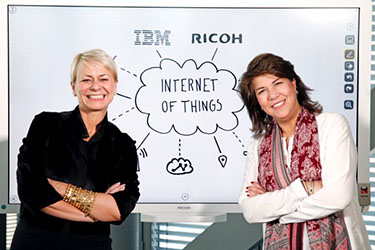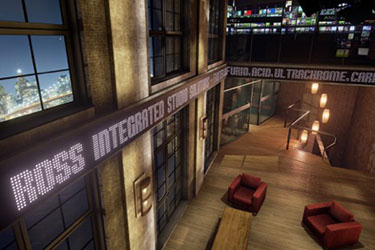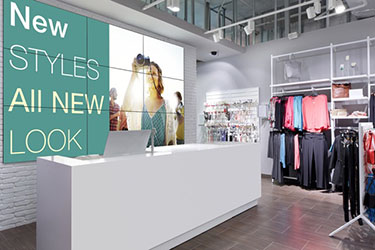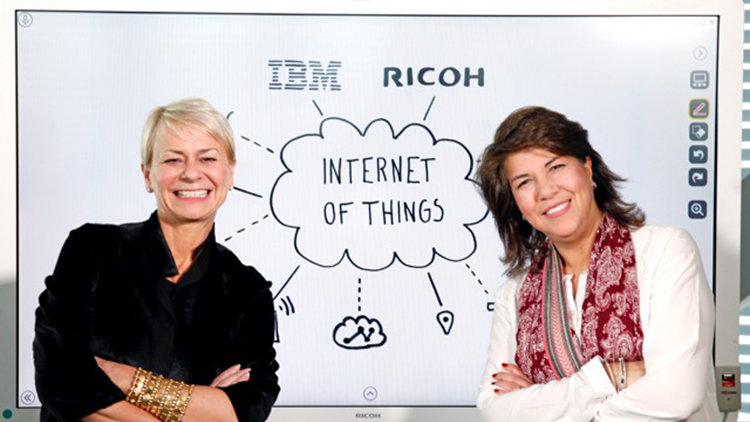A recent report by Markets and Markets reveals that the digital-out-of-home market will grow from $12.52 billion in 2016 to $26.21 billion in 2023. The research firm says that this is due to an increase in spending on programmatic advertising, and advances in technology as well as infrastructure.

IBM and Ricoh are transforming corporate meeting spaces with Watson-powered interactive whiteboards. (Pictured) IBM General Manager Watson IoT Harriet Green and Senior Vice President, Services, Ricoh Americas, Mona Abutaleb celebrate the Watson-Powered Interactive Whiteboard which bring new efficiencies to the workplace.
Photo courtesy of IBM
“Digital signage has been in a consistent transition from a basic rotation of static signage, to an interactive experience that engages and interacts with the viewer,” said Todd Heberlein, business development manager at Almo Professional A/V, a professional audiovisual equipment distributor headquartered in Timonium, Md. Manufacturers of digital signage technology, he says, are taking advantage of this through the use of touch technology and Beacons. He cites Brightsign’s media players as an example: “Brightsign has more than 10 different ways for a user to interact with the Brightsign media players, ranging from a simple button push or touch on a touchscreen, to the recently added Beacon technology. The Beacon technology is ever-expanding, and allows the hardware to virtually reach out and engage with smartphone users in the vicinity.”
IoT and the Power of Data
One frequent discussion in the AV community is how the Internet of Things (IoT) is influencing the development of digital signage technology. Rich Ventura, vice president of strategy at NEC Display Solutions of America, a display manufacturer headquartered in Chicago, Ill., notes that in the retail environment, digital signage can follow the consumer right to the fitting room, where it can propose articles that complement the clothing the customer has brought in to try on. “[If] I know, as a retailer, that those clothes are in there––say you took in two pairs of jeans and two shirts––I can then trigger content: here’s a matching jacket,” he illustrated. “I can also let the store personnel know that there’s a person in there [with these products] and they want to see this jacket. It creates this whole new level of engagement that you didn’t have before.” In this example, IoT combines with big data to up-sell to the consumer.

Ross Video and The Future Group are offering Frontier, a Virtual Studio Graphics Rendering platform produced by the collaborating companies. “Frontier raises the broadcasting bar for virtual and augmented reality productions with incredible levels of creative design freedom that are combined with hyper-realistic rendering quality for virtual sets that are much more natural and convincing,” said Gideon Ferber, director of Marketing Product Management for Ross Virtual Solutions.
Throw in artificial intelligence (AI), and these systems can begin addressing inventory goals. Ventura offers this example: sensors placed within a store detect a female customer, aged 20 to 25, wearing a pink shirt. After consulting what’s in stock (and what items need to move) AI automatically generates a personalized advertisement proposing several articles of clothing that match the shirt the customer is wearing, and offers a 20 percent discount if she purchases those items during her visit. “On the back end, it’s building this whole knowledge base for the retailer, and now the retailer becomes smarter, and they can watch their inventory levels, they can watch their ordering patterns,” he said.
While all of this is possible, it’s not necessarily feasible yet for many organizations. Futuresource Consulting Ltd., a market research firm based in Hertfordshire, United Kingdom, questions whether retailers are positioned to apply sophisticated IoT/big data solutions yet: “The retail sector offers a fascinating case study for this juxtaposition with the tantalizing prospect of truly personalized customer information, and subsequent messaging, offset by a landscape often still struggling to implement basic AV installations,” the firm said in a statement provided to AV Technology. It’s not technology that is holding things back, the firm notes; hardware costs have decreased, the software exists to provide targeted messaging in real-time, and consumers are equipped with the mobile devices to receive it.
While Futuresource concedes that there are always innovative organizations out there that will adopt new technology and push it to its optimum, “ … in the main the retail sector is still in the generalist phase when it comes to the use of analytics. Key consumer data points are still in siloes, if they exist at all … retailers are focused on understanding general consumer behavior and movement through the store, tending to use heat mapping and audience recognition tools to (at best) drive basic demographic. There is little evidence of true personalization, even when a retailer is running a loyalty card program.”
AR and the Wow Factor
The need to “wow” the customer remains strong, however, and some retailers are starting to embrace the incorporation of augmented reality (AR) into their digital signage deployments. Futuresource highlights virtual mannequins––which are used as a sort of “magic mirror” that enables consumers to virtually apply makeup or try on clothing––as one such application that has been deployed by the retailer Top Shop.

“On the back end, it’s building this whole knowledge base for the retailer, and now the retailer becomes smarter, and they can watch their inventory levels, they can watch their ordering patterns.”
–Rich Ventura, NEC Display Solutions of America
Predictably, Disney is getting into the game with the filing of several patent applications that will enable it to display augmented reality objects onto surfaces in the company’s theme parks, according to Futuresource. Visitors will be able to view these objects without the need for a headset or smart glasses, and, eventually, manipulate them.
While organizations are often focused on digital signage applications indoors, for Ventura, the outdoors provides ample opportunity to reach consumers and boost brand engagement. “That’s the next step when you look at the natural progression of the industry: how do we increase engagement outside? How do we gather more information and drive more communication with the consumer? That’s where IoT devices are going to be really important,” he said, adding that 5G will facilitate these opportunities. “5G is going to speed up mobile data, and it’s going to allow us to push more through the pipe a lot faster. That’s always been the limiting factor of wireless when it comes to digital signage, and outdoor [applications are] going to benefit from it the most.”
AI, APIs, and Collaboration
While slightly outside of the traditional digital signage category, interactive whiteboards are now being enhanced with AI to increase the value proposition for users. One example of this is the partnership between IBM Watson IoT and Ricoh. The two organizations teamed up in 2017 to elevate the collaborative experience with Ricoh’s cognitive-enabled interactive whiteboard using IBM’s Watson intelligence and voice technologies. The new solution supports people in meetings by responding to commands, taking notes and actions, and even translating content into other languages.
According to a 2017 Ricoh press report, the Intelligent Workplace Solution leverages IBM Watson IoT and Ricoh’s interactive whiteboards to change the way teams meet and collaborate through new intuitive features that can be accessed using natural voice. “It makes sure that Watson doesn’t just listen, but is an active meeting participant, using real-time analytics to help guide discussions so teams can make faster, better and more informed decisions,” the company stated.
Features of the cognitive-enabled whiteboard include global voice control of meetings. Once a meeting begins, any employee, whether in-person or located remotely in another country, can easily control what’s on the screen, including advancing slides, all through simple voice commands using Watson’s Natural Language API.
The system is enhanced with translation services. The Intelligent Workplace Solution can translate speakers’ words into several other languages and display them on screen or in transcript.
What’s more, with a swipe of a badge the Intelligent Workplace Solution can log attendance and track key agenda items to ensure all key topics are discussed. Users can also hold side conversations that are displayed on the same whiteboard.
“Collaborative workforces are at the heart of successful business. The challenge is bringing disparate teams together and then enabling them to be productive,” said Harriet Green, General Manager, Watson IoT. “With IBM’s Watson IoT technologies, Ricoh’s interactive whiteboards don’t just guide meetings; they foster an open exchange of ideas and make it easy for teams to work in partnership and bringing meetings to life.”
IBM is practicing what it preaches. It has installed more than 80 Ricoh interactive whiteboards in its global Watson IoT headquarters in Munich, Germany.
Carolyn Heinze is a regular AV Technology contributor.
MORE INFO
Almo Professional A/V
www.almo.com
Futuresource Consulting Ltd.
www.futuresource-consulting.com
NanoLumens
www.nanolumens.com
NEC Display Solutions of America
www.necdisplay.com
Ricoh
www.ricoh-usa.com
Ross Video
www.rossvideo.com
Future Group
www.futureuniverse.com
